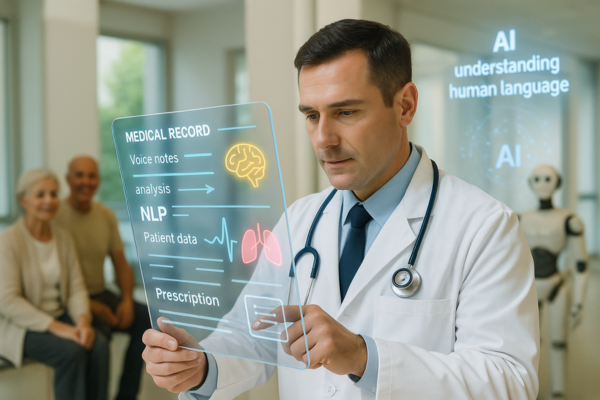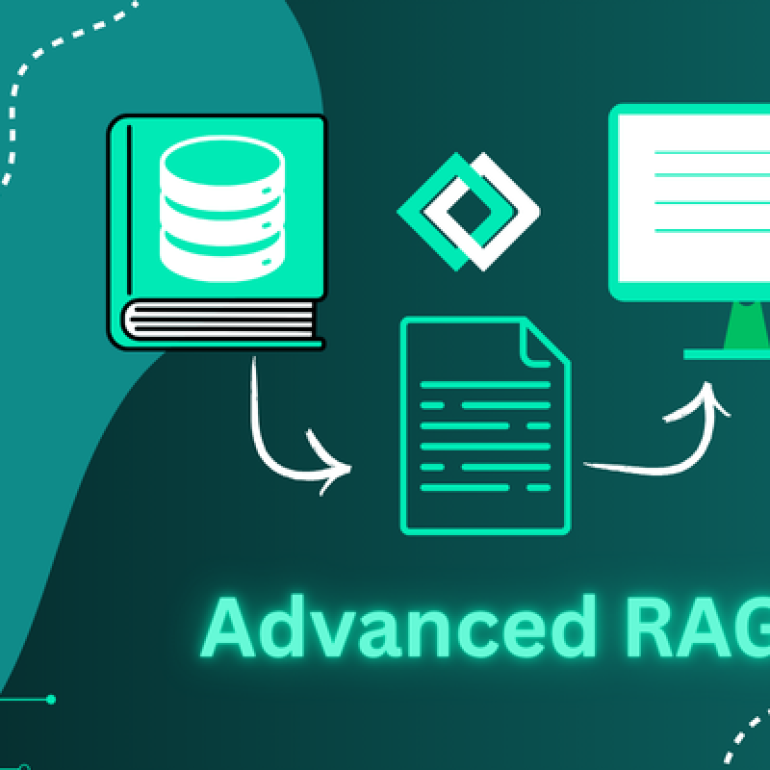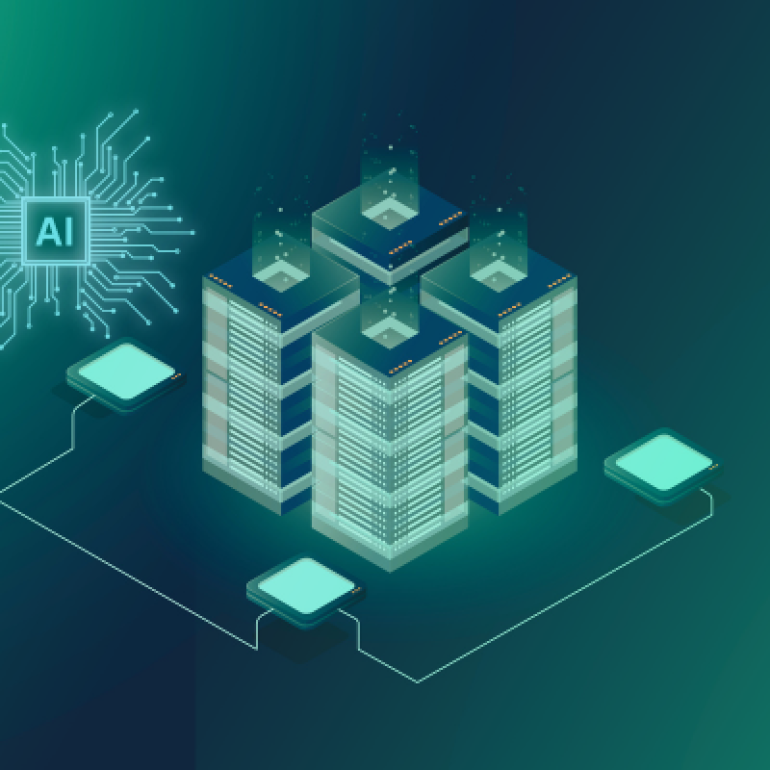- 12 July 2025
- Dr. Chandra Bondugula
Revolutionizing effects of NLP in healthcare
Natural Language Processing (NLP) in healthcare helps computers understand human language. Every day, healthcare produces vast amounts of data like clinical notes, patient records, research articles, and administrative documents. Traditional data management struggles to keep up often leads to inefficiencies and potential errors.

NLP: Why do unfolding healthcare and AI need human comprehension?
Natural Language Processing (NLP) in healthcare helps computers understand human language. Every day, healthcare produces vast amounts of data like clinical notes, patient records, research articles, and administrative documents. Traditional data management struggles to keep up often leads to inefficiencies and potential errors. NLP tackles these challenges by enabling machines to understand, interpret, and respond to language.
Most of the healthcare data is unstructured. NLP is transforming industries worldwide, and healthcare is no exception. Medical literature and data are complex. Healthcare demands precise documentation and better patient care, making it a prime candidate for NLP innovation. By leveraging Natural Language Processing in Healthcare, providers can analyze large amounts of unstructured data, enhance decision-making, and streamline operations.
Why is Natural Language Processing in healthcare strategically surpassing the traditional electronic record-keeping process?
As of 2023, Natural Language Processing in Healthcare is valued at USD 2.7 billion and is projected to reach USD 11 billion by 2028. Experts say, “Revolutionizing healthcare and life sciences improves the quality and quantity of patient care and predictive analysis.” Advancing AI in healthcare is crucial, especially as life expectancy declines post-pandemic.
The shortage of doctors, medicines, support staff, and life support knowledge remains an unspoken issue. Is this a sign that we’re preparing for computers to take charge in future pandemics? Before diving into that debate, let’s understand the whys and whats of NLP.
How does NLP help in revolutionizing healthcare?
Let us assume AI in healthcare to be a big umbrella, whereas NLP is a small trinket that hangs by the edge. Natural Language Processing in Healthcare enables computers to break down large datasets into smaller, easily understandable bits. The healthcare industry already has many references and processes that need a simple, quick-access point to streamline operations. It involves machine language, various linguistic systems and models, deep learning to interpret the data easily while semantic understanding of text as well.
Why do we need Natural Language Processing in Healthcare to revolutionize healthcare?
1. Improved documentation
NLP enables data extraction of relevant information from unstructured notes and summaries and makes it easy to understand and convert into structured data.
This reduces the administration burden tremendously whilst minimizing error and increasing patient-doctor satisfaction.
2. Enhanced patient care and decision-making
NLP helps to easily scan through medical literature and data, clinical matter, patient data, and Electronic Health Records to support informed decision-making. It also helps in identifying proper clinical trials, improved treatment processes, and accurate diagnostic measures.
AI chatbots and virtual assistants also help in advancing engagement by giving responses, scheduling appointments, and medicine reminders in real time.
3. Improving predictive analytics and early diagnosis
NLP helps in understanding patient symptoms, medical histories, and test records easily and quickly. It helps in identifying risks and diseases by comprehending existing health patterns. This helps in facilitating various chronic diseases like cancer, cardiovascular issues, diabetes, etc.
4. Speeding Up Research and Drug Development
NLP scans and analyzes extensive repositories of research papers, clinical trials, and patents to extract valuable insights. This accelerates AI in healthcare and medical discoveries, medical literature, and data, identifies drug interactions, predicts patient responses to medications, and streamlines clinical trial recruitment.
5. Sentiment Analysis and Patient Feedback
NLP processes patient feedback from surveys, social media, and online reviews to identify sentiments and areas for improvement. This data-driven approach enhances patient satisfaction, loyalty, and care outcomes by addressing common concerns promptly.
How does NLP help us in real-life situations?
1. Clinical Named Entity Recognition (NER) Models
(i) Purpose: Extract key medical terms for research and patient care.
(ii) Real-Life Impact: Imagine a doctor reviewing a patient’s history filled with lengthy, handwritten notes. A Clinical NER model automatically scans these records to highlight important terms like diseases, medications, dosages, and procedures. This saves time and reduces the risk of overlooking critical information.
(iii) Example: In oncology, NER can quickly identify mentions of tumor markers, treatment protocols, and patient responses across thousands of records, helping doctors personalize treatment plans.
2. Clinical Entity Resolver
(i) Purpose: Matches clinical notes with medical codes (like ICD-10) for accurate billing.
(ii) Real-Life Impact: Billing errors in healthcare can lead to financial losses and compliance issues. A Clinical Entity Resolver acts as a translator between medical language and coding systems.
(iii) Example: A physician’s note says, “Patient exhibits signs of Type 2 diabetes with complications.” The resolver maps this description to the correct ICD-10 code (E11.9) automatically, ensuring accurate billing and smooth insurance claims.
3. Relation Extraction Models
(i) Purpose: Identifies relationships between medical concepts to support better decision-making.
(ii) Real-Life Impact: Healthcare isn’t just about isolated facts; it’s about connections. Relationship extraction Models analyze clinical texts to find links between symptoms, diagnoses, treatments, and outcomes.
(iii) Example: In cardiology, it can be identified that chest pain (symptom) is often related to myocardial infarction (diagnosis) and linked to the use of aspirin (treatment). This helps flag potential health risks or guide diagnostic decisions.
4. Assertion Models
(i) Purpose: Determines whether a condition is present, absent, or possible in clinical notes.
(ii) Real-Life Impact: Doctors write notes like “Patient denies chest pain” or “Possible signs of infection.” Without context, this could lead to confusion. Assertion models analyze the language to clarify whether a condition:
(a) Is present: “Patient has a fever.”
(b) Is absent: “No signs of infection.”
(c) Is uncertain/possible: “Rule out pneumonia.”
(iii) Example: This is critical in emergency settings where decisions need to be made quickly. It helps triage patients more accurately based on the severity of their conditions.
5. Patient Sentiment Analysis
(i) Purpose: Evaluate patient emotions to improve care quality.
(ii) Real-Life Impact: Hospitals receive tons of feedback through surveys, social media, and patient portals. Sentiment analysis scans this feedback to detect emotions like satisfaction, frustration, or anxiety.
(iii) Example: If many patients complain about long wait times in the emergency room, sentiment analysis will highlight this as a recurring negative trend. Healthcare providers can then address the issue to enhance patient experience.
Challenges and Ethical Considerations
While Natural Language Processing in healthcare holds great promise
it also presents challenges, including data privacy, security concerns, and the need for high-quality, unbiased data. Ensuring compliance with regulations like HIPAA and maintaining the integrity of clinical decisions are critical.
The Future of Natural Language Processing in Healthcare in Healthcare
The future of Natural Language Processing in healthcare is bright, with advancements expected in diagnostic tools, personalized treatments, and predictive models. Technologies like voice-enabling and multilingual NLP models will break language barriers and improve global healthcare accessibility.
NLP is revolutionizing healthcare by enhancing clinical workflows, improving patient care, accelerating research, and supporting decision-making. As healthcare continues to embrace this technology, we can anticipate more efficient, cost-effective, and personalized solutions that benefit providers and patients alike. Natural Language Processing in Healthcare is at the forefront of this transformative journey, paving the way for a more sustainable and innovative healthcare system.




